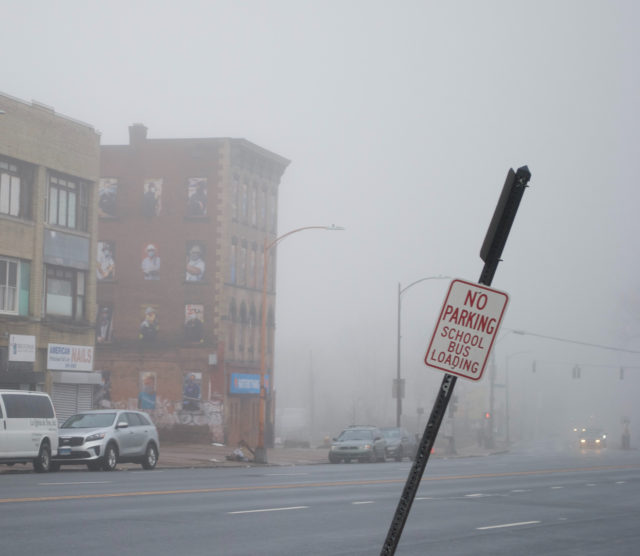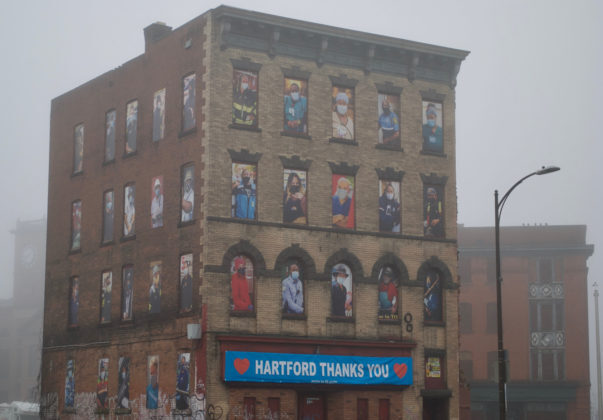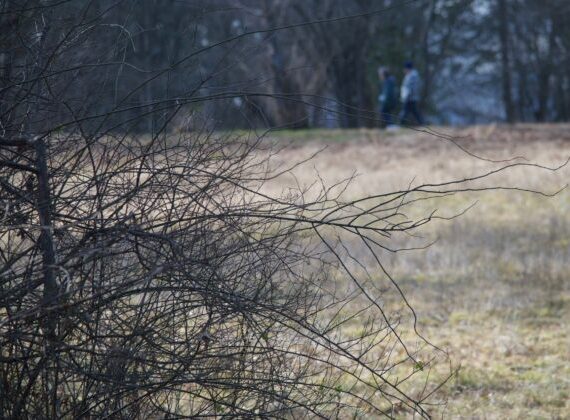The former Arrowhead Cafe building on the edge of Downtown and the Clay Arsenal neighborhood is the site of Joe Gaylor’s latest photo installation/exhibit in Hartford. The subject: regular people doing their jobs while dressed responsibly during a pandemic.
If you’ve visited the Parkville Market patio, followed the local artist on Instagram, or viewed previous posts on Real Hartford, then you have seen other examples from Gaylor’s frontline workers series. Another of his photos — this one of a Black Lives Matter march through Frog Hollow — is posted on a Capitol Avenue building.

To get the 35 photos installed last week, Gaylor was assisted by Hartford’s Forestry Division and Department of Public Works.
Among those featured on where Main, Albany, Ely, High, and Ann all come together: Jimmy Barrett, the Homeless Outreach Officer with the Hartford Police Department. During the pandemic there has been a noticeable, undeniable increase in people sleeping outdoors; tents have popped up in most if not all of Hartford’s major parks, not to mention in other locations like below highways and atop bridges spanning railroad tracks. On a rainy day when temps were only slightly above freezing, I have seen a woman panhandling on an interstate ramp, in her socks. No shoes. Not even sandals. While the cheap rhetoric has consisted of telling people to “stay home,” this sentiment ignored the needs of those living without a permanent address, and in Hartford, that’s been estimated as around 850 people. Part of what Barrett has opted to do is connect those in need with more appropriate clothing — something that will become even more important as it gets colder.
Bus drivers and grocery store employees are among others featured in this ensemble of frontline workers. If you don’t recognize at least one of the people on the building, are you even living in Hartford?
What’s not to like about an exhibit that shows respect for those who don’t have the privilege of working remotely these days, and does so not just with words but by placing faces to the concept of the “essential worker,” in a very visible way at one of Hartford’s busiest intersections?


Richard
Yes to art of the people in more ways than one. When these times become history let us hope that portraits such as these make the art history books. Then let us hope that there is still someone around who can do a good Marxist analysis of workers who had to go to work each day, and those in the comfortable classes protected by the big corporations who can work from home. This divide among the working class is so apparent for those who want to take a look. This divide is and should be used as a call to action. I would love to see each one of these photo’s come with a summary of who the worker is, what do they do, and who do they work for. Then one step further what is their rate of pay. I would also like to see everyone of these essential workers get hazard pay beginning with the grocery store clerks at Stop and Shop and other stores. It is nice to have reminders in art such as this but we must use this art as a call to action other wise it might as well be a vase of flowers.